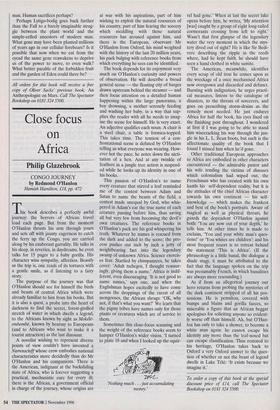Twilight in paradise
Myles Harris
THE ISLAND OF THE COLOUR BLIND by Oliver Sacks Picador, £16.99, pp. 293 Darwin when he saw his first kangaroo wondered if the Pacific might not hide 'a second creation'. Dr Sacks in his book The Island of the Colour Blind remarks how he was 'strangely pleased' when he read Dar- win's phrase:
Islands were, so to speak, experiments of nature, places blessed or cursed by geograph- ic singularity to harbour unique forms of life: the aye-ayes and pottos, the lorises and lemurs of Madagascar; the great tortoises of the Galapagos, the giant flightless birds of New Zealand — all singular species or gen- era which had taken a separate evolutionary path in their isolated habitats.
Sacks takes us there to look, but being a neurologist he does not look for weird ani- mals but weird diseases, evolutionary blind alleys.
On the tiny island of Pingelap in the Car- olines some of the inhabitants are born with a total inability to see colours. The defect first showed itself on the island in 1820. Now out of 800 islanders 57 are achromats. Called by the locals `maslcun', by doctors achromatopsia, the disease makes children appear normal at birth but after a couple of months they screw their eyes and heads away from the light. They lack colour receptors in their retinas and need huge lenses to read. Had they been born on a planet lit by the equivalent of moonlight — perhaps by a sun ten times as far from earth as ours — they would have been perfectly adapted, but the harsh glare of the earth's sun nearly blinds them. There were achromats elsewhere on the earth, but now the incidence outside the islands has dropped to tiny numbers.
In one village Sacks comes across a mat decorated with grey and purple inks made by an achromat who lives in a perpetual, colourless twilight.
The island's finest weaver was a colour blind woman . . . As we adapted to the darkness [in her hut] we began to see her special art of brightness, delicate patterns of shifting lumi- nances, patterns that disappeared as soon as we took one of her mats into the sunlight outside.
This eerie otherworldliness is maintained when Sacks visits the Chamorro people on the island of Guam. Here he sees the dis- ease Lytico-bodig. Some of its victims are locked in a profound motionlessness, some shake, others go mad. It is unexplained. It was once thought to have been triggered by eating the fruit of the cycad tree. This 100- million-year-old species lives in the rain forest on the islands. The sinister pods are found all over the Pacific and are, unless carefully washed, highly poisonous. Fadang flour was made from the cycad and at times the population was dependent on it. Sacks, who confesses to a lifelong fascination with cycads, talks of 'forces that press to evolu- tion and extinction' reaching at us from the Jurassic Age.
This is a wonderful book, made better by Sacks' exceptionally gentle descriptions of patients. He also captures the unimagin- able sadness of the Pacific. The Fall, if it occurred, happened there. The Pacific was once the haunt of cannibals. Whole popu- lations ate each other amid scenes of aston- ishing beauty. At the end of the book we come across the following:
Most of the statues of Easter Island do not, in fact, face the sea; they face away from the sea, toward what used to be the exalted house of the island. Nor are the statues eye- less — on the contrary, they originally had startling brilliant eyes made of white coral, with irises of red volcanic tuff or obsidian.
Whatever they watched it was the work of man. Human sacrifices perhaps?
Perhaps Lytigo-bodig goes back further than the Fall to a barely imaginable strug- gle between the plant world and the simple-celled ancestors of modern man. What gene may have been planted millions of years ago in our cellular forebears? Is it possible that now when we eat from the cycad the same gene reawakens to deprive us of the power to move, to even walk? What better parable of the forbidden fruit and the garden of Eden could there be?
All orders for this book will receive a free copy of Oliver Sacks' previous book, An Anthropologist on Mars. Call The Spectator Bookshop on 0181 324 5500.



















































































 Previous page
Previous page